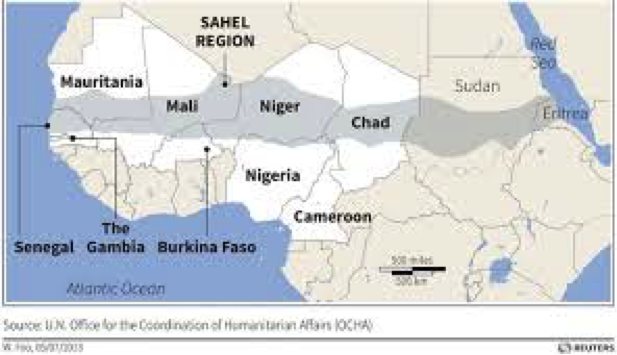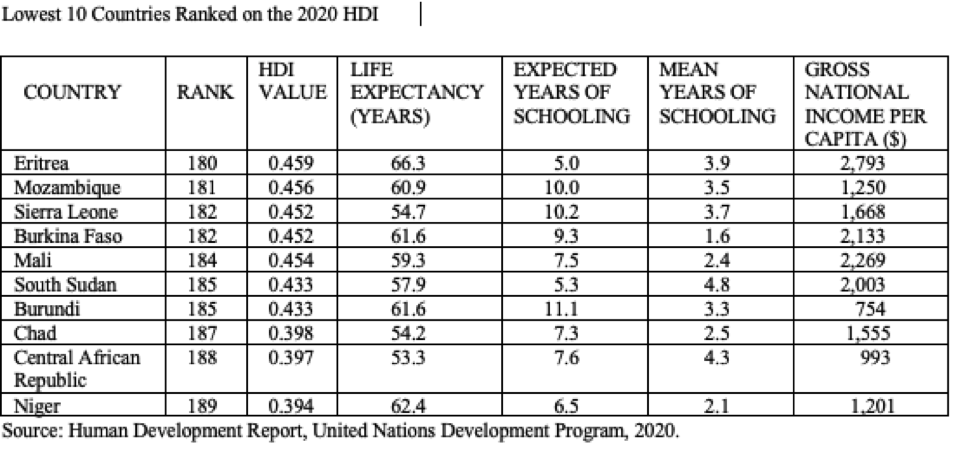by Mark G. Wentling
The main assistance theme of the U.S. Agency for International Development (USAID), U.S. embassies, other donors, and host government agencies in the impoverished Sahel Region of Africa has been focused for a decade on strengthening the resilience of rural households eking out a living on the edge of the Sahara Desert. More than 40 million people reside in this marginal arid geographic area, mostly pursuing subsistence agricultural and pastoral livelihoods. The countries most concerned by this effort to build rural resilience are Burkina Faso, Mali and Niger.

USAID and other donors have provided hundreds of millions of dollars to fund resiliency activities in the Sahel. These costly endeavors have kept hundreds of thousands of desperately poor people from becoming poorer and enabled them to better withstand natural disasters, but they have not advanced their countries to a higher developmental stage. USAID and other major donors are thus confronted with cruel options.
Does USAID continue spending its limited funding on keeping poor people from becoming poorer or does it invest in supporting activities that have the potential to lift the country’s development ranking? With assistance funding unlikely to be increased, USAID will be faced with making a choice: either it continues supporting resiliency and related activities or it switches its focus to supporting activities that enhance a country’s overall development status.
Prioritizing Education and Health
A country cannot raise its development status without major improvements in both education, including formal, non-formal, vocational and training needed to respond to the job market, and health, including family planning, nutrition, sanitation and water. Therefore, if the aim of USAID and other donors is to help advance the development status of a country, these organizations must augment their support in these sectors. Although many other needs beg attention, until measurable progress is made in these two sectors, these three Sahel countries (and others) will remain mired in the lowest ranks of the poorest countries in the world.
The U.S has expended hundreds of millions of assistance dollars since these countries gained independence in 1960 and there is little credible evidence to demonstrate a lasting impact on improving the development status of these countries. Over this period, the U.S. has funded activities in almost every conceivable assistance area, but this assistance has been fragmented and inconsistent. To have a minimum chance of making a lasting positive difference, assistance funding should be concentrated for an extended period on education and health rather than spread over a wide variety of activities as well-meaning “Pixie Dust.”
In retrospect, if the U.S. had concentrated its assistance resources on education and health over the past several decades instead of spreading its assistance over many sectors, the development prospects of these countries would likely be much better than it is today. For example, if the U.S. had focused on quality primary school education for girls, these countries could have achieved greater gender equity and better health. No country in the world has made notable advances in development until a majority of its population has benefitted from a quality primary school education. And without more high school graduates, progress is greatly constricted.
Coping with Geographic Vulnerabilities
Undoubtedly, the geographic location of these Sahelian countries assures periodic suffering from drought and other crises. The aim of many projects funded by donors is to enable vulnerable people living in this marginal land to minimize their losses when crisis strikes. Ideally, these people learn to engage in coping mechanisms that allow them to recover quickly from crises and thus are enabled to stay on a track more favorable to greater growth. This approach may save many lives, but it does not advance a country to a higher development status.
Without substantial improvements in health and education, these countries will always remain in the low human development category. U.S. efforts in the Sahel should, therefore, be focused on improving the ranking of those countries in the low human development category (LHD) on the United Nations Development Program’s Human Development Index (HDI), acknowledging that this cannot be done without giving priority to improving education and health status indicators.

As most African countries (30 out of 33) were listed in 2020 in the LHD category at the bottom of the HDI, these 30 countries, or a subset of them, should be given special attention by U.S. assistance agencies. At the same time, the U.S. government should acknowledge that its main interest in these countries is the well-being of their people and not natural resources or any other strategic concern.
Persistent Childhood Malnutrition
Improving the welfare of Sahelian families is a daunting challenge that requires a long-term engagement if the downward cycle of impoverishment is ever to be reversed. An important factor in this downward spiral is persistent child malnutrition. Although everyone recognizes the seriousness of this decades-long crisis, it remains difficult to obtain the funding needed to address this issue on a consistent, widespread basis. I speak from experience. In 2013 when I was working in Burkina Faso, I transmitted a child nutrition improvement proposal to a handful of major donors agencies; all gave high marks to my proposal but claimed to have no funding for it.
It is not possible for a country to have a better future when 30 to 40 percent of its children are stunted and, therefore, permanently robbed of achieving their full potential as adults and more susceptible to contracting a debilitating disease. For the Sahel and all of Africa to advance, every child must receive the care and feeding their bodies need during the first 1,000 days of their lives. A healthy start in life is required in order to have a chance to thrive.
The challenges today in the Sahel are much greater than those following the great Sahelian drought of the early 1970s. The population has more than tripled in size since then and consists predominantly of children. Each household thus has three to four times as many mouths to feed. At the same time, the purchasing power of each household has decreased as the cost of essential items has risen dramatically. And more people than ever are displaced due to the violent actions of criminals and extremists.
A farm family must now produce and sell at least three times as much today as it did 30 years ago to buy the same essential items. This production must be derived from a smaller average farm size and soils that have been typically degraded. Furthermore, there are now an unprecedented number of landless rural people because there is not enough land to go around for the fast-growing population. This new landless situation adds to the rural exodus which fuels fast urbanization, which usually means a huge growth in urban slums.
Climate Change Increases the Challenges
Climate change is making things worse and adding to the challenges. Moreover, the variability in rainfall in the Sahel has changed the context of resiliency programming. There has not been a widespread major drought in the Sahel for a decade. In some areas, excessive seasonal flooding has become more of a problem than the scarcity of rainfall. Resiliency programming born from the previous devastation caused by recurrent droughts is likely no longer applicable.
The U.S. decision to close aid missions in Burkina Faso and Niger in the late 1990s was not helpful. On a per capita basis, the U.S. and other donors are offering less aid today than they did 30 years ago. Yet, many countries in the Sahel remain dependent on external budgetary aid. Part of the job of donor agencies should be to earmark a large percentage of this aid for the education and health sectors. Certainly, U.S. diplomatic and development assistance missions in the Sahel need to have the funding necessary to play a greater role in making improvements in these two sectors.
Thirty years ago, a good harvest and a full household granary could tide a family over until the next harvest. This is no longer the case; the population has grown to the point where some countries cannot produce enough to feed their people even in the best of years. Under these circumstances, can a resiliency strategy succeed in achieving its objectives?
It is clear more jobs are needed, but jobs need to be filled by educated and healthy people. Without improving the education and health status of the upcoming generation, the huge ‘youth bulge’ in the Sahel will result in jobless youth being all too ready to join extremist groups and criminal gangs.
The artisanal gold mining boom in some Sahelian countries is changing the face of many rural landscapes across the region. Many farmers have abandoned agriculture to scrape for a living in artisanal gold mining pits. This presents new challenges to social stability and the environment.
The Need for Competent Governance
Obviously, nothing will work well without honest and competent governance and stability. Over the years much of the good work done by USAID, other donors and host governments to raise household incomes and resiliency has been undone by poor local governance, military coups, armed rebellions, terrorist attacks, lawlessness, and popular uprisings. Without peace, stability, and favorable conditions over the long term, lasting household resiliency cannot be achieved.
Of course, the diplomatic-development agenda in Africa’s Sahel Region is long, costly and complex. More work is needed to remedy numerous deficiencies, including the large infrastructure deficit, financial reforms, deficient key institutions, and creating the conditions attractive to private investors who can create good paying jobs. None of this is possible without citizens who enjoy good health and a high-quality education. Any resiliency achievements are ephemeral without solid progress in these areas.
Resiliency is Not Enough
The fact is that the people of the Sahel already possess a high resiliency level. If they were not already resilient, they could not survive in the harsh living conditions that prevail in many corners of the Sahel. Perhaps a different set of indicators is needed to measure the well-being of Sahelian inhabitants.
From birth, all Sahelians are conditioned to adopt resilient behaviors in order to survive. Knowing the Sahelian mindset is important to understanding how the people have survived for generations in such a harsh environment, as is learning how they are coping with changes in their challenging circumstances. Without this knowledge, any diplomatic-development assistance approach is likely to fail in achieving its objectives. And, if education and health status indicators remain low, prospects for a better future are dim.
Building resiliency is therefore not a development solution. Increasing household resiliency may keep some impoverished people from falling off the edge of survival, but it will not develop their countries. National development requires a long-term concentration on raising the level of education and health status indicators. There are plenty of good things to do, but if education and health indicators are not improved, a county will not develop.
Assistance that gives long-term priority to making improvements in these fundamental areas should be the focus of future diplomatic approaches and development strategies elaborated in Washington in collaboration with U.S. missions in the Sahel. USAID needs to decide if it will continue to use its limited funding in areas that do not raise the development status of a country, or if it will focus on supporting over the long-term improvements in the education and health sectors that have the potential to lift countries out of the lowest human development rankings.
A revised approach to assistance in this region, with its many funding and staffing implications, will ultimately depend on the support it may garner from the leadership provided by the new administration. Foreign aid is long overdue for reform; putting greater priority on education and health would be a good way to start.
Even without additional funding, there is much USAID can do now to re-orient its priorities to assist the poorest of countries to advance. Closing USAID missions operating in countries not in the low human development category would allow greater assistance to LHD countries. A decision to focus on LHD countries would send a signal that the U.S. is serious about helping the poorest countries escape the lowest ranks of human development. Perhaps this is not a perfect solution, but the alternative is to continue to see these countries ranked for decades to come at the bottom of the human development index.![]()

Mark Wentling retired in 1996 from the Senior Foreign Service after serving as USAID’s principal officer in six African countries. He has also worked in Africa for the Peace Corps, Non-Governmental Organizations and as a contract employee with USAID. His decades in Africa have afforded him the opportunity to have known each of Africa’s 54 countries. He has published eight books, including last year his three-volume Africa Memoir, 1970-2020. The latter multi-volume book covers all 54 African countries.
